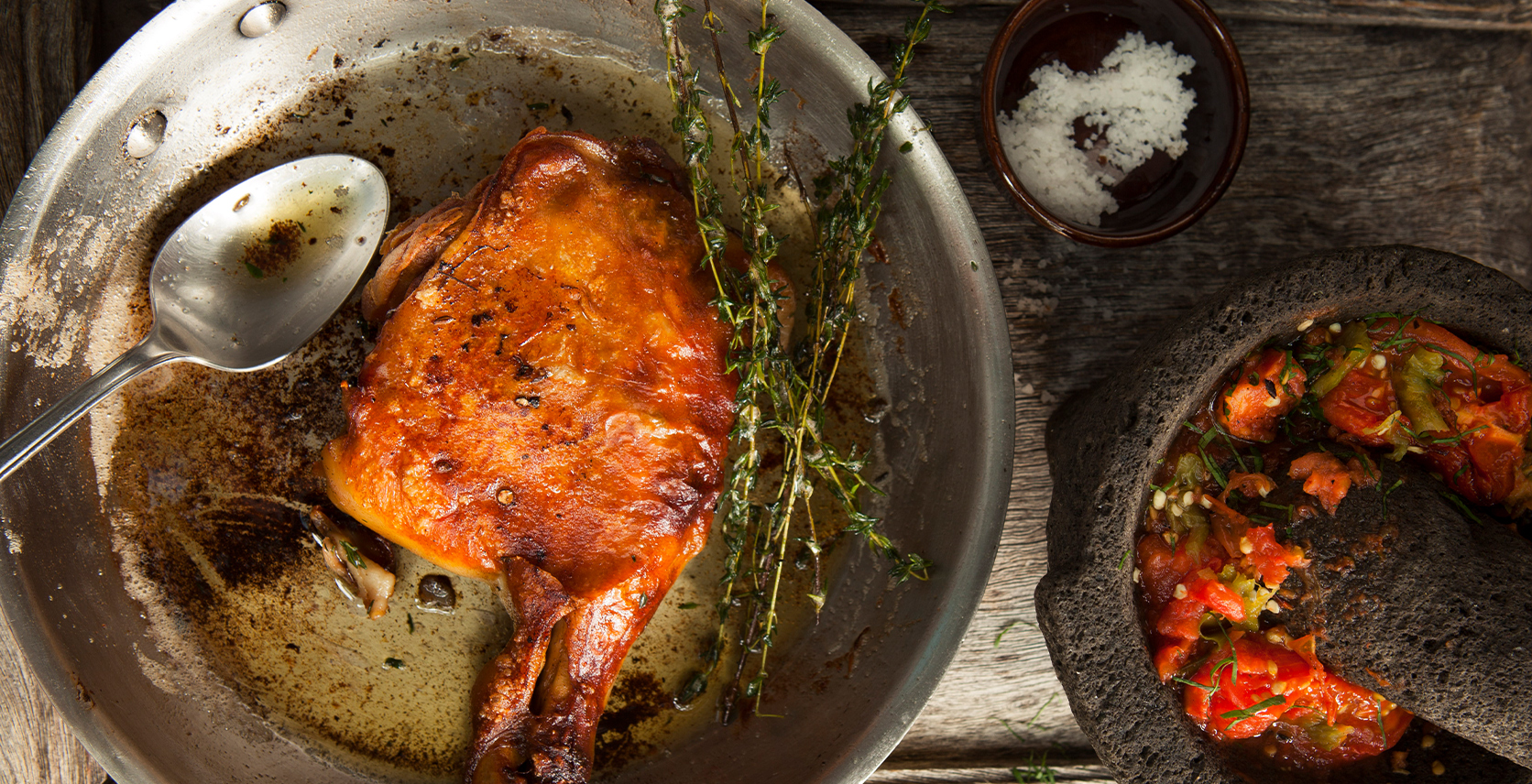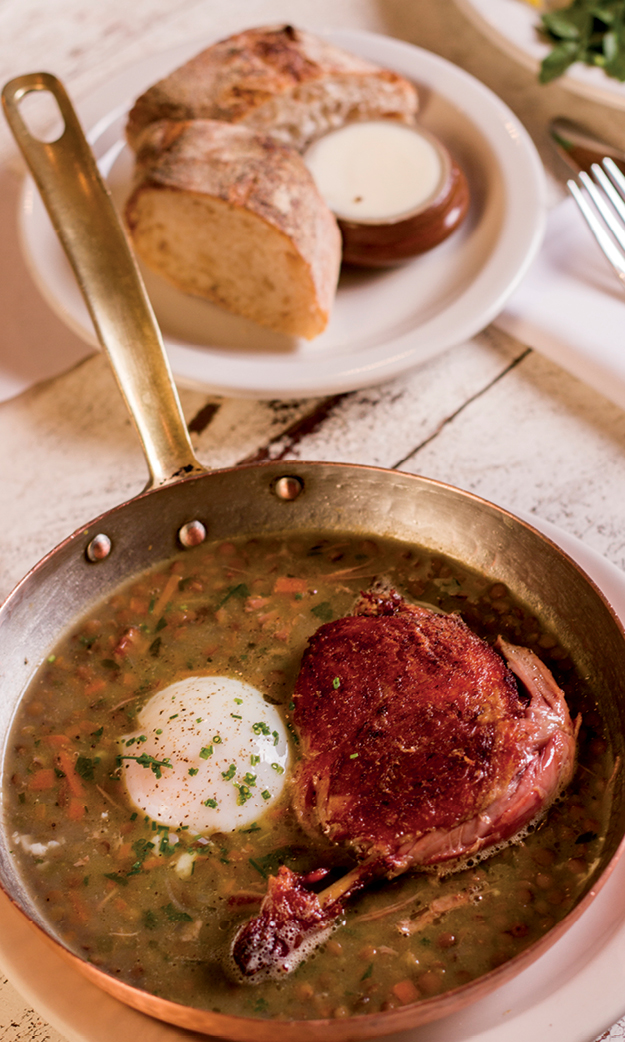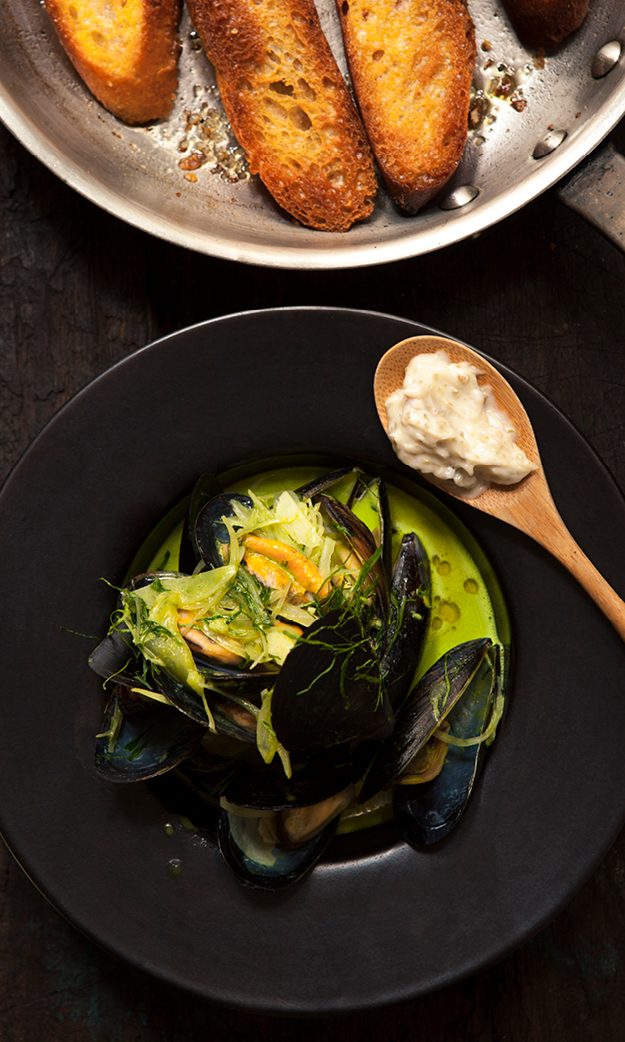How Mexico City’s Finest Chef Is Battling His Country’s Corruption
It’s five in the morning in Mexico City and Eduardo Garcia is shopping at the Central de Abastos, the biggest produce market in the world. The market is a vast city of food within a vast food-centric city. Mountains of food. Overwhelming quantities. More food than you could ever imagine. Some 15,000 people come to work here every day in the countless warehouses and stalls sprawled over its 800 acres, unloading cauliflower and apples and lettuce from rusted out Toyotas and semi-trucks, peeling cactus paddles for export to China, bagging onions. If you eat a taco by the roadside or an arugula salad in a fancy Italian restaurant in Mexico City, chances are some part of it passed through here on its way to your plate.
Despite the early hour, Garcia moves purposefully through the labyrinthine corridors of the Abastos, stepping deftly over floors slick with a mash of discarded leaves. On either side are piles of squash blossoms, pallets of onions, pyramids of limes. The air is cacophonous with whistles, shouts and Mexican pop music blaring from radios. Men balancing handcarts piled with vegetables hustle in every direction.
Garcia darts through the aisles, jumping between topics as he goes: the inscrutable workings of the market, the disastrous effects of free trade on Mexican gastronomy, and the differences between the produce destined for Walmart and the stuff grown using traditional Aztec methods.
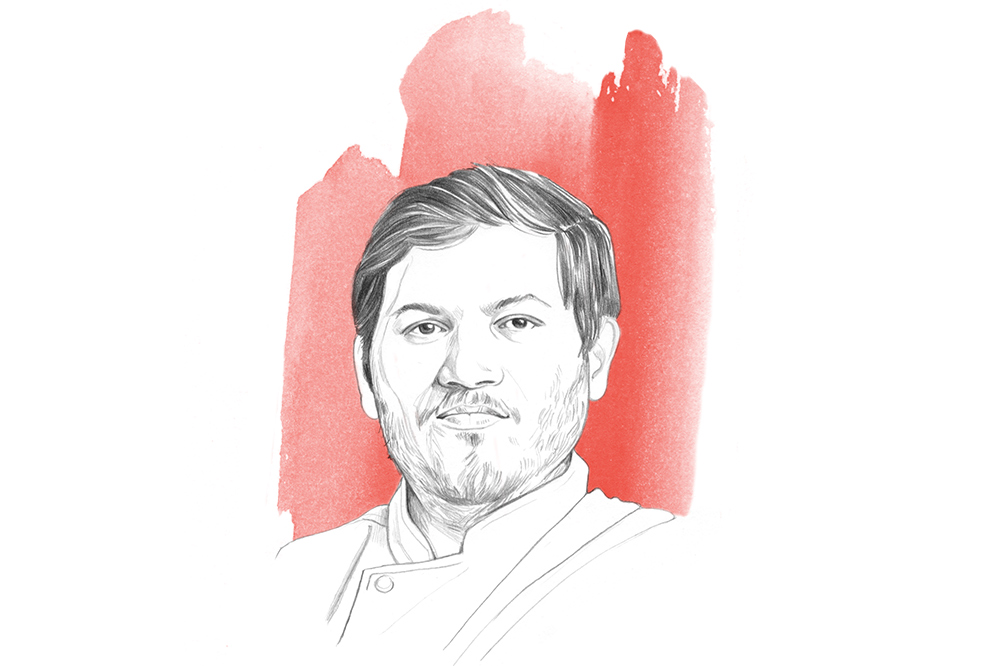
“Remember this,” he says pointing to a mountain of greens on one seller’s table. “This is cilantro.” A few stalls down he holds up another bunch, stunted-looking and dirty, with small, intensely green leaves. “This is creole cilantro, and you can tell the difference just by the roots and the colour. This is the only way that produce should be grown. It’s not super clean, it’s not perfect, but it’s probably the tastiest.”
Garcia is the owner of three restaurants in Mexico City and the co-owner of five more. His first was Maximo Bistrot, which opened in 2011, and while his other two (Lalo, a casual diner, and Havre 77 a French brasserie and oyster bar) are newer, it’s Maximo Bistrot where the chef still spends the majority of his time. The restaurant is one of the top reservations in the city, frequented by politicians and socialites and praised by S.Pellegrino and Anthony Bourdain. His menu, which combines French and Italian dishes with traditional Mexican flavours, changes daily, incorporating what’s freshest at the Central de Abastos, and what he brings in from a carefully cultivated network of suppliers. The 38-year-old chef has a lot to say about food — about agricultural methods, about heirloom vegetables, about the traditional farms, or chinampas, that still operate on the city’s canals — but it’s never just food he’s talking about. To Garcia food is not just sustenance and culture and history, it’s economics and politics, too.
Garcia knows very well who Maximo Bistrot’s customers are, but he’s grown a reputation as much for his food as for standing up to the bullying of Mexico’s notoriously corrupt ruling class. Soon after Maximo opened, the daughter of an influential politician arrived at the restaurant during a busy dinner service, insisting she be seated immediately at a table of her choosing. After being rebuffed, first politely by the Maitre d’, then less politely by the chef himself, she had them shut down. The story made headlines around the world, a perfect David and Goliath narrative in a place where speaking out can have deadly consequences. The politician lost his job, Garcia became a hero and Maximo Bistrot reopened. “There’s not much you can do in Mexico,” he says of the incident. “If you speak and the government hears you speak, they will shut you down. People disappear out of nowhere. So you just live life and never make a big deal.” Occasional run-ins with the country’s elites aside, Garcia does most of his agitating through the thing he knows best: food.
Eduardo Garcia has been in restaurant kitchens since his early teens, working his way from dishwasher to sous chef in Atlanta, to a stint a Le Bernardin in New York, but his understanding of food runs much deeper than cooking on the line. “I grew up in the fields,” he says matter-of-factly, describing a childhood spent picking fruit and vegetables alongside his parents as they migrated across the United States, following the harvests from Texas to California to Michigan. “We were illegal, so I never went to school. When I was 10 I was making the same money as my parents working in the fields.” Born in a small village in central Mexico, Garcia’s story is the same as that of countless Latin American migrants who keep the American agriculture industry running. It was his upbringing that instilled in him an indefatigable fierceness that’s essential to both who he is and what he does. After being permanently deported from the US, where the rest of his family (including his son, Maximo) still lives, Garcia started again in Mexico City, beginning with a job at Enrique Olvera’s top-rated Pujol, and three years later, striking out on his own.
Throughout the market, Garcia points to examples of attractive looking produce that will never see the inside of his kitchen. For him, beauty (and taste) reside in the small and imperfect, food that bears the marks of the land from which it came. This rejection of aestheticism is a recurring theme with Garcia. He is as intolerant of giving space on his plates to nice-looking, poor-quality ingredients as he is to giving jobs to anyone who won’t work as hard as he does, regardless of their resume.
“I get all these kids from culinary schools and they’re fucking worthless,” he says, adding that his best employees are indigenous farmers he’s recruited from the market. “I get these guys who don’t even know how to read and write. I teach them and they love it. Because no one’s ever given them the opportunity to grow anywhere.” In a country that’s deeply divided along racial as well as economic lines, staffing a high-end restaurant with indigenous Mexicans from the lowest castes of society is, to say the least, atypical. But that’s one of many ways in which Maximo Bistrot is not typical. Where Mexico City’s other top fine dining restaurants are defined by architect-designed interiors and expensive artwork, Maximo’s aesthetic is an exercise in restraint and humility: plain white adobe walls, heavy wood- en furniture, no tablecloths. “Not all Mexicans will come to a place like this,” he says. “Sometimes we get the President here or the minister of agriculture. Sometimes we have a really rich girl with a Louis Vuitton bag who looks at the restaurant and says, ‘I’m not going in there.’”
Despite the endorsement of former boss Enrique Olvera, Maximo Bistrot’s success was by no means a sure thing. “When I finished building Maximo I had $400 to my name,” Garcia says. “For two and a half years I slept two hours a day until my restaurant started to do well.” His timing, however, was good, and his focus on pared-down, seasonal food coincided precisely with the rise of farm-to-table cuisine around the world.
The irony of privileged people paying top-dollar to eat the kinds of traditionally grown ingredients their grandparents took for granted is not lost on Garcia. “When I was growing up in my village, we only ate from the lands,” he says, recalling that as recently as 20 years ago life in rural Mexico had more in common with the 19th century than the 20th. “Everybody had their own chickens and if you wanted pork, you slaughtered your own pig.” According to Garcia, globalization and free trade have had a disastrous effect on these communities, where cheap, processed foods have replaced centuries-old diets. “Now,” he laments, “not even the people on the farms eat their own eggs. The ones who used to eat really healthy are the ones who are eating shit now. It’s not their fault, but it’s sad.” He’s far from the only one to observe the ways in which the new global economy has ravaged Mexico’s rural poor. North American free trade encourages farmers to grow exports like strawberries and melons, and makes imported junk foods like instant noodles cheap and abundant. Among the results are sharply rising rates of obesity and diabetes, and farmers who can’t feed themselves from their own land.
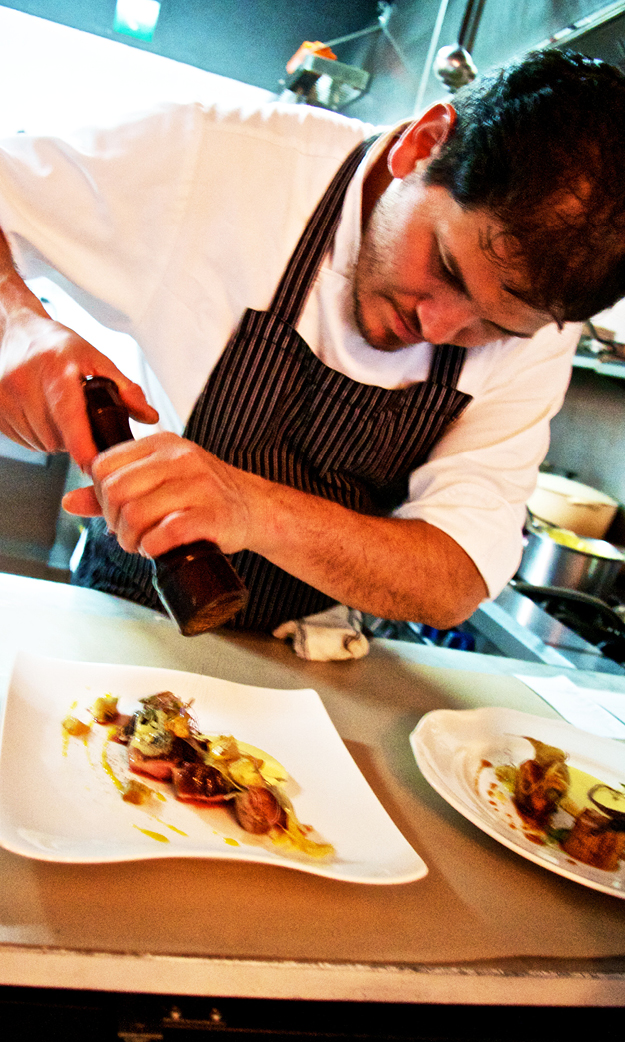
Part of Garcia’s obsession with ingredients comes from his admiration for perfectionists like Olvera and Le Bernardin’s Eric Ripard, but that doesn’t explain the lengths he goes to get the right kind of cilantro, a certain kind of locally-foraged mushroom, or seasonal non-GMO corn. “It’s not a matter of conscience,” he says. “I don’t look for an organic or a sustainable producer because it’s trendy or because it’s going to make me a better person. I do it because I know that it’s better.” Then Garcia pulls out his phone to show off pictures of his Hungarian heirloom pigs, the buffaloes that produce his mozzarella, the Durango wagyu cattle that furnish his beef. Every morning at 3am one of his staff goes to the airport to pick up a shipment of fish flown in from the Pacific coast. “I know exactly where every single one of my ingredients comes from,” he says, flipping through the photos of livestock like a proud parent. “I know exactly who’s growing them, what they’re feeding them and where they’re getting slaughtered.”
To any other chef this fanaticism about provenance and quality might be purely driven by taste, but to Garcia it’s a matter of right and wrong. A moral distinction. Food should be grown a certain way. Farmers should be respected. Traditional methods should be preserved. The results are delicious, of course, but that sometimes feels like effect rather than cause.
Evidence of Garcia’s philosophy can be found in every plate his kitchen produces. Beautifully presented without being precious, his ingredients take centre stage: a vibrant clam ceviche with watermelon radish and avocado puree, a perfectly cooked filet of red snapper topped with delicate micro greens and rich green mole, buttery-tender lamb encrusted with parsley, served alongside a fragrant wild mushroom risotto. It succeeds as the best food does, by being simple and complex at the same time. Garcia’s food doesn’t shout, it speaks instead in lines of prose, measured and balanced, each dish letting each ingredient tell its story with dignity and clarity. The story it tells depends entirely on how closely you’re listening.
